MXA RACE TEST: THE REAL TEST OF THE 2023 KTM 450SXF
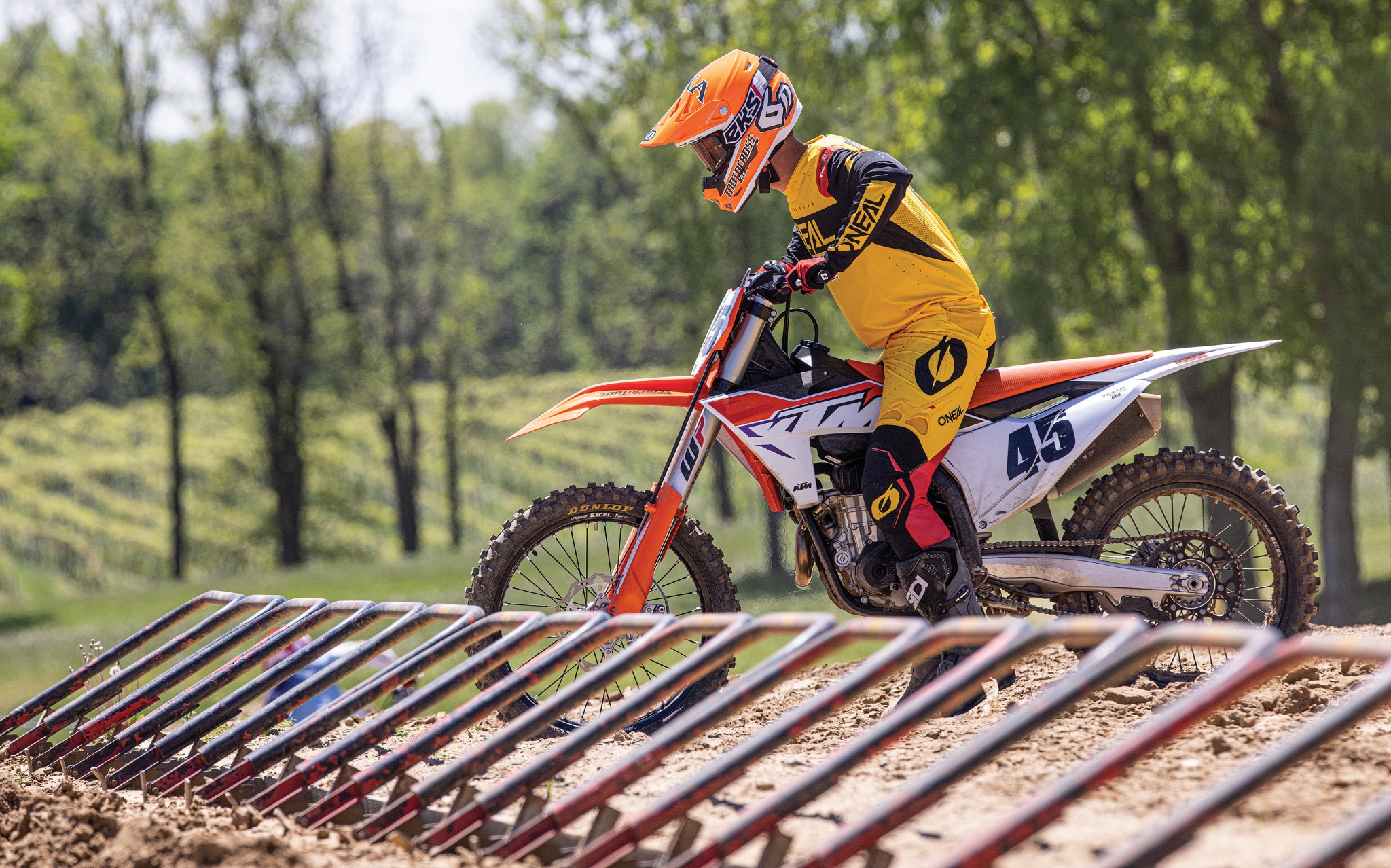 THE GEAR: Jersey: O’Neal Prodigy, Pants: O’Neal Prodigy, Helmet: 6D ATR-2, Goggles: EKS Brand Lucid, Boots: Sidi Atojo.
THE GEAR: Jersey: O’Neal Prodigy, Pants: O’Neal Prodigy, Helmet: 6D ATR-2, Goggles: EKS Brand Lucid, Boots: Sidi Atojo.
Q: FIRST AND FOREMOST, IS THE 2023 KTM 450SXF BETTER THAN THE 2022 450SXF?
A: Yes and no, but mostly yes—although, you have to jump through a few hoops and learn some new things to live happily ever after with it.
Q: DOES KTM HAVE A POWERBAND STRATEGY AMONG ITS THREE BRANDS?
A: Yes and no, but mostly yes. For years, KTM haters, even those who owned the bikes, complained about three things:
(1) Low-to-mid pickup. The 2022 KTM 450SXF (and by proxy the 2019, 2020 and 2021 models) delivered a mellow, manageable and easy-to-use power delivery from off-idle all the way to the midrange. It was obvious that it could have hit harder, offered quicker throttle response and jumped onto the pipe sooner. The Austrian designers did this by design, but the criticism was still valid.
(2) Map options. For the last five years, MXA has complained that the difference between Map 1 and Map 2 was not significant enough. We had tested several maps with KTM’s R&D department and loved a new aggressive map called the “American map.” We felt that it should replace the existing Map 2 because it was livelier, snappier and more responsive; however, the Austrian engineers didn’t share our love of the “American map,” and thus it never made it onto a production KTM 450SXF.
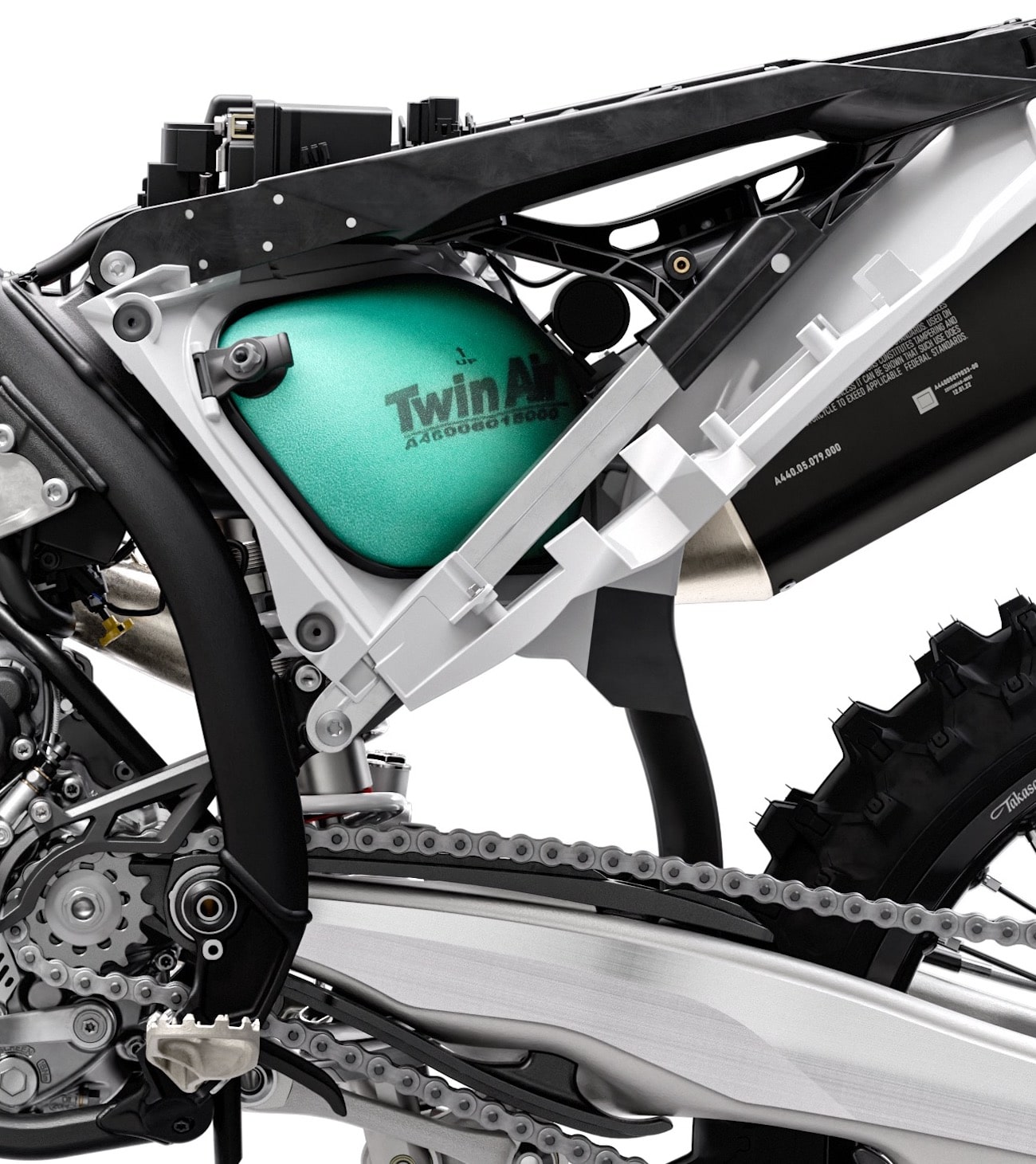 Back on the Austrian assembly line, airbox design is what differentiates the powerbands of the GasGas, KTM and Husqvarna.
Back on the Austrian assembly line, airbox design is what differentiates the powerbands of the GasGas, KTM and Husqvarna.
(3) Airbox. We are fully aware that the Austrian giant uses airbox design, defined by how much air is allowed into the airbox, as a way of delineating the power characteristics of the KTM 450SXF, Husqvarna FC450 and GasGas MC450F. The KTM 450SXF gets the largest air vents. The Husqvarna gets medium-sized vents, and the GasGas breathes through a straw. By limiting the flow of air, the three identical Austrian engines deliver distinctly different powerbands in the low-to-mid range. As you can guess, throttle response is muted by reduced airflow, which makes the suffocated engines on the Husky and GasGas mellower, easier to ride and more pleasant for the less brave. The Austrians weren’t happy when MXA began drilling holes in their airbox covers, even though their race teams did the same thing. Eventually, they bit the bullet and offered optional airbox covers (for KTM and Husky only). Not surprisingly, the vented KTM airbox cover flows more air than the optional Husky airbox cover.
Q: WHICH BRAND’S STRATEGY WORKS THE BEST?
A: When you ask this question, you are missing the point. What would be the logic of KTM making three identical motorcycle brands? Their strategy is to make three brands, each with a distinctive envelope of performance that suits a different rider. This is not a surreptitious corporate plot at the Mattighofen headquarters, but rather an effective way to market three different motorcycle brands that aren’t all that different. It would be too expensive to design purpose-built KTM, Husqvarna and GasGas engines, each with its own bore and stroke, compression ratio, valve train and engine cases, but by the same token, KTM wants the orange, white and red machines to have their own unique personalities (with the caveat of not costing millions of dollars to produce). Thus, mapping (or, in the case of GasGas, limited map options) and airbox designs are seamless solutions that deliver a more responsive KTM, broader Husqvarna and mellower GasGas.
This strategy isn’t limited to engines only. Each brand gets its own unique suspension setup crafted to meet the needs of the brand’s target demographic. The KTM gets firmer suspension that rides higher in its stroke and is stiff enough to take on big bumps and even bigger jumps. The Husqvarna gets the same basic valving and shock spring rate as the KTM, but both ends are lowered to make the bike easier to get on for Vet riders (who KTM believes make up the majority of the Husky demographic). The upside of Husqvarna’s lowered suspension is that it makes the Husky handle better than the KTM. The GasGas is spec’ed with softer fork valving mated to a rear shock that is spec’ed with a 42 N/mm shock spring, while KTM and Husqvarna get a 45 N/mm spring.
Pricing is also used to delineate the three brands, with Husqvarna being the most expensive (perhaps because its buyers are typically older with more disposable income). KTM only undercuts the Husky price tag by a tick (perhaps because it is for more serious racers without the financial safety net), and the stripped-down GasGas MC450F is priced to compete head to head with the Japanese brands—but since the 2023 GasGas’s got a price increase for 2023, they are still cheaper than their Austrian brothers, but also more expensive that the Yamaha, Honda and Kawasaki that they originally aimed for.
That, in a round-about manner, leads us back to the “American map.” MXA felt that the American map was the best option for the American style of racing, where even the most backwoods of local tracks favor hard acceleration out of the corners, instant pickup to clear doubles and snappy throttle response. The Austrian engineers and marketing men didn’t think that such an aggressive map, even when combined with their mellow map, would work for their European clientele’s riding styles or racetracks. The Austrians asked the question, “What would be the point of making a powerband that only Americans would like?”
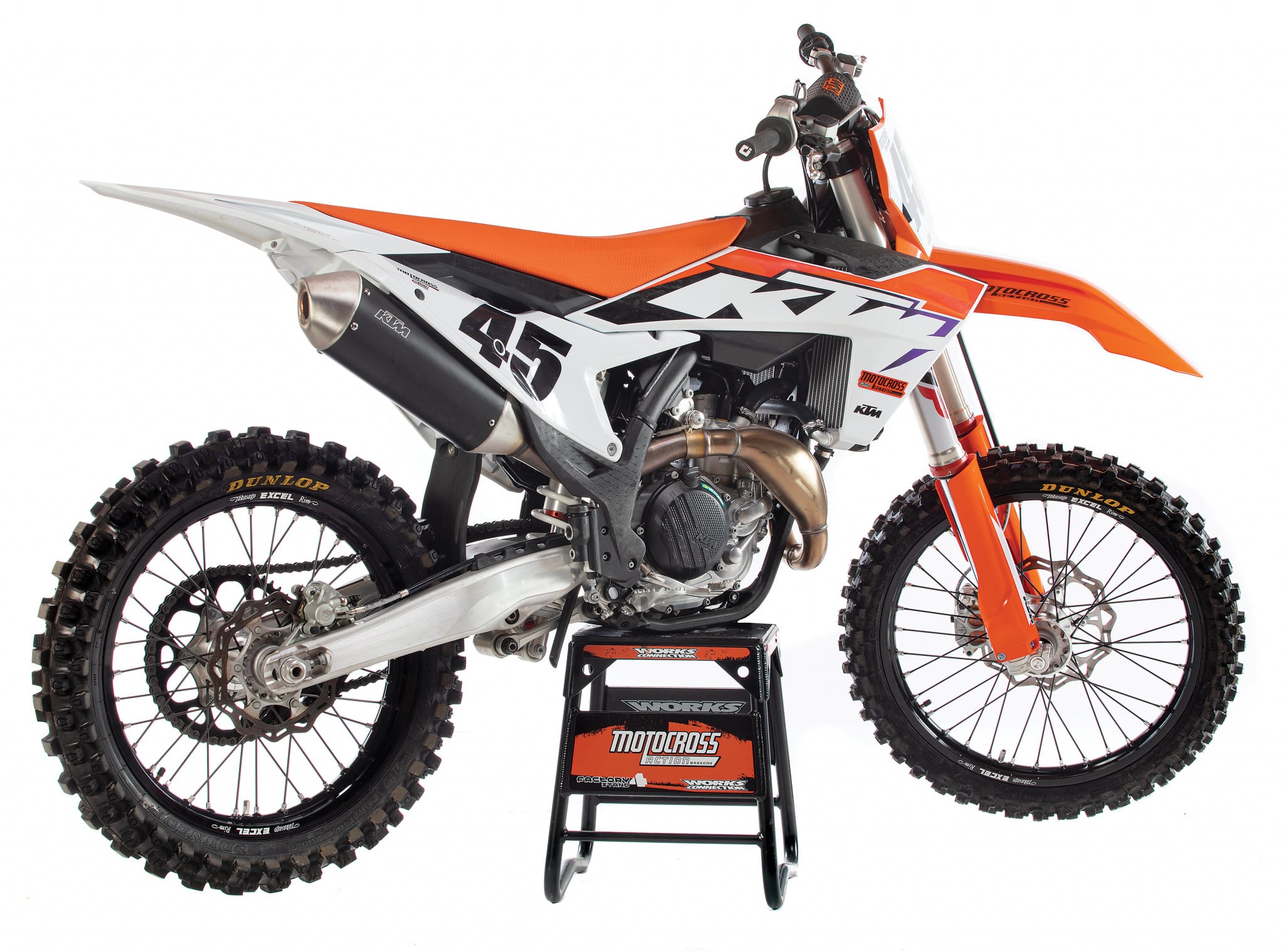 The 2023 KTM 450SXF is the most technically advanced motocross bike on the track. From its bodywork to its electronics to its ergonomics to its power to its overall design, it is cutting edge.
The 2023 KTM 450SXF is the most technically advanced motocross bike on the track. From its bodywork to its electronics to its ergonomics to its power to its overall design, it is cutting edge.
Q: WHAT WOULD BE THE POINT OF MAKING A POWERBAND THAT ONLY AMERICANS WOULD LIKE?
A: Even without breaking out a calculator, it is easy to understand that with almost 50 percent of the KTM factory’s motocross output being sold in North America, it would behoove KTM to address the three issues pointed out in the first paragraph of MXA’s 2023 KTM 450SXF test—low-to-mid pickup, mapping differentials and airbox design—which is exactly what they did on the 2023 KTM 450SXF
(1) Low-to-mid pickup. The 2023 KTM 450SXF is a rocket ship in Map 2 compared to the 2022 KTM 450SXF. Conversely, Map 2 is smoother than Map 1 at low rpm. Most MXA test riders started out in Map 1, feeling that Map 2 was scary fast. But, before the end of their first day of testing, they all switched to Map 2. They adapted to the feel, and if they didn’t, they stayed in Map 2 but geared the bike taller by running 13/50 (3.846 ratio) sprockets instead of the stock 13/51 (3.923 ratio). For Vet riders, the best combination seemed to be an even taller 14/52 (3.7146 ratio). Changing the gearing to alter the power delivery is not an unusual solution. Honda would often gear the CR500 two-stroke taller when consumers complained that it was too brutish down low.
(2) Map options. Map 2 is exactly what most KTM 450SXF owners have been asking for—more power! Conversely, Map 1’s detuned power is the answer to the request for a bigger difference between Maps 1 and 2. Unlike on previous KTM 450SXFs, there is a noticeable difference between Map 1 and Map 2. And, if you doubt that based on your seat-of-the-pants evaluation, we dyno’ed both maps. Map 1 gave up a couple horsepower to Map 2 from 5000 rpm until narrowing the gap at 8700 rpm. Even though Map 1 may have inched closer to Map 2 at 9400 rpm, it was still 2 horsepower down. And the difference grew to 3 horsepower by 11,000 rpm.
(3) Airbox. On the 2023 KTM 450SXF, all the air coming into the airbox is routed through two vents on each side of the airbox. The two air vents are designed to look like handholds. They are positioned above and behind the air filter, and even have a V-shaped dome under the seat base to help redirect the air in a downward direction. All in all, it is a vastly improved airbox in terms of volume and air ingress, and KTM has a vented airbox cover to seal the deal. There is one airbox strategy that the Austrian engineers kept as part of the grand plan. On the 2023 Husqvarna FC450, which uses the same airbox as the 2023 KTM 450SXF, the free-flowing hand-hold vents on the 2023 KTM are closed off on the Husky. And, since the 2023 GasGas MC450F is unchanged from 2022, it barely breathes at all.
Q: HOW DID IT RUN ON THE DYNO?
A: The peak horsepower on the 2023 KTM 450SXF was 59.85 horsepower (in Map 2). At just a hair under 60 horses at 9400 rpm, the KTM 450SXF is exceptionally strong from 8500 rpm until its 11,400-rpm sign-off. Torque is 37.01 pound-feet at 7100 rpm. For comparison, the 2023 KTM 450SXF peaked at only 56.79 horsepower in Map 1.
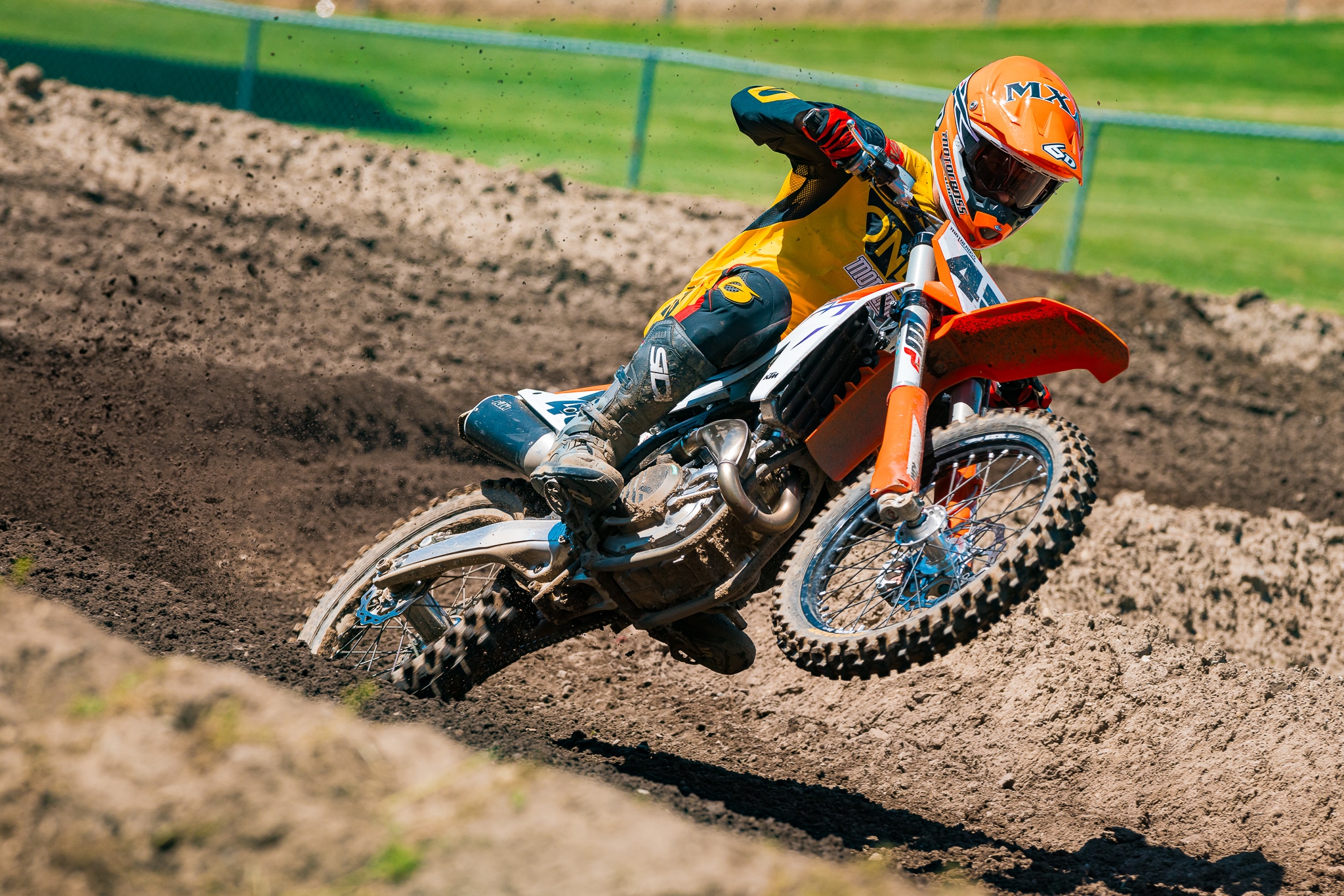 KTM riders have been asking for a bigger difference between Map 1 and Map 2. The 2023 KTM 450SXF delivers that in spades.
KTM riders have been asking for a bigger difference between Map 1 and Map 2. The 2023 KTM 450SXF delivers that in spades.
Q: HOW GOOD ARE THE 2023 WP XACT AIR FORKS?
A: WP reworked the forks and shock for 2023 with the goal of making the damping firmer at both ends of the stroke. As far as mechanical changes go, the WP XACT air forks got new valving and Hydro-Stop bottoming cones, which use a tapered shape to create an “oil lock” to stop the forks from bottoming. Overall, the forks aren’t that different from the 2022 WP AER air forks except in two areas. They resist bottoming with a vengeance and are firmer at the beginning and end of their travel.
However, there is one major and annoying caveat to how the 2023 WP forks work; they don’t work very well for the first couple hours. The WP forks are set up from the factory with tight tolerances. This is good for the long haul, but not so sweet in the short run. We want to warn you that your first ride on the WP XACT AER air forks will be the worst ride of your life. Husqvarna, KTM and GasGas forks come off the assembly line very stiff for the first few hours of riding. Test riders who raced the bike at two hours hated it, but two weeks later, when the forks had four hours on them, the exact same test riders, on the exact same bike, on the exact same track, loved them.
Don’t judge the 2023 KTM 450SXF forks by the first couple hours on them. Take the time to break them in. They will get better with each ride, and you’ll be happy with them once they have five hours on them. MXA had more than enough test riders to speed up the break-in process, but it is not easy for a lone rider to get full use out of the forks riding once a week. However, since the forks get better with each ride, it is not inconceivable that you will start to like them after two hours.
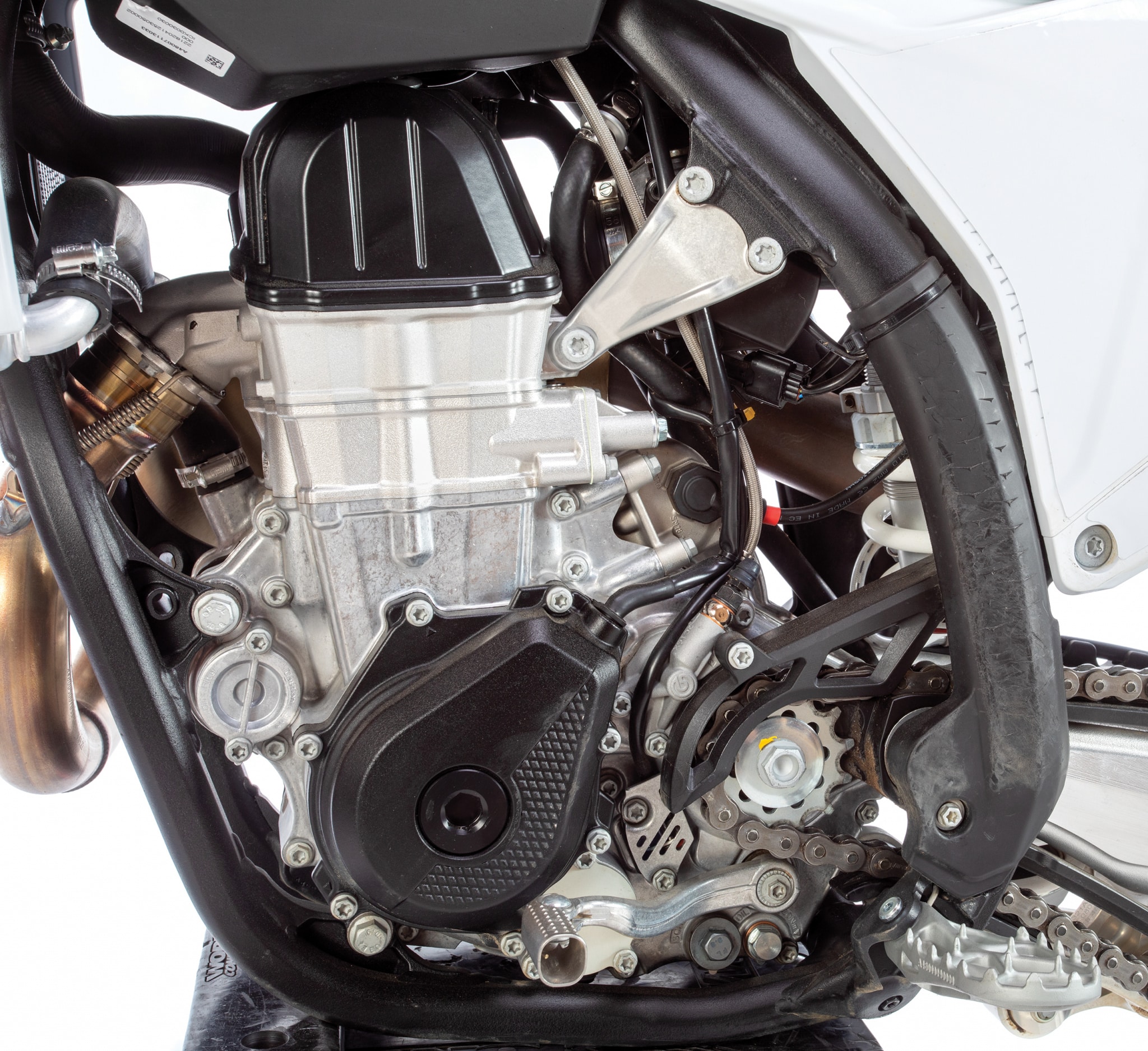 The engine is rotated backwards by 2 degrees. This lowers the countershaft sprocket by 3mm, which in turn lessens chain torque under acceleration. The compression ratio is upped from 13.75 to 14.1, and peak power is 59.85 horsepower.
The engine is rotated backwards by 2 degrees. This lowers the countershaft sprocket by 3mm, which in turn lessens chain torque under acceleration. The compression ratio is upped from 13.75 to 14.1, and peak power is 59.85 horsepower.
Q: WHAT ABOUT THE WP REAR SHOCK?
A: Because of the new frame, which we will get to shortly, the rear shock and shock spring are 15mm shorter. The goal was better overall packaging to fit with the new shock tower design and revised shock linkage (which has its pivots moved up to raise the link arms farther off the ground). Additionally, the new shock/spring combo saves 100 grams (3.5 ounces). Even though the shock and spring are shorter, the shock’s stroke is unchanged from 2021, and the spring rate is still 45 N/mm.
If the shock was stressed it would bottom…hard. We surmise that the rising rate at the end of the stroke needs to be stiffer. Expect the aftermarket companies to build new shock linkages that start a little softer initially and get progressively stiffer at the end of the stroke. Until that happens riders can try feeding in more low-speed compression damping to help with hold-up or send their shock to their favorite tuner—and have him focus on more compression damping in the last 25% of the shock’s travel.
It has taken over five decades, but KTM has done something that every rider will appreciate. All the compression and rebound clickers on the 450SXF shock and forks can be adjusted by hand. No need for a screwdriver to adjust compression or rebound, just turn the dial. The rear shock is even more whiz-bang. Its clicker dials look like a pinwheel, with easy-to-use clickers for high-speed compression and low-speed compression on the reservoir, while the rebound clicker is on the bottom of the shock clevis (it, too, can be adjusted by hand, but it isn’t as easy).
Q: HOW DOES THE KTM HANDLE?
A: It feels quite a bit different from the 2022 KTM 450SXF chassis, especially in the first couple of hours, which had several MXA test riders saying that they would rather race their 2022s than the new 2023. But, as with the forks, the frame needs to be broken in. Unlike the forks, which break in relatively quickly, KTM’s chromoly chassis doesn’t take a set until sometime between 8 and 10 hours of ride time. Why? KTM engineers went to great lengths to make the frame stronger and more rigid, especially in the head tube area.
If you have been around long enough, you’ll remember when KTM did the same thing in 2018 when they added stamped gussets to the head tube, backbone and downtube. Guess what? If you thought the 2018 frame was too stiff, you’ll have the same feeling about the 2023 KTM 450SXF frame. The big difference is that instead of 2018’s stamped metal gussets, the 2023 frame has ultra-strong, forged-steel brackets on top of the frame’s backbone (behind the head tube), and, no surprise, forged brackets on the down tube (below the head tube). These forged pieces make the frame more durable and stronger, but because of them, this frame needs a lot of break-in time. The five hours on the WP forks is just a warm-up for the frame. Our frame got closer to its natural resilience with every hour of saddle time. It was perfect at the 10-hour mark. These sound like ridiculous break-in times, but you don’t have to wait for 10 hours. The chassis will feel better every time you ride it. You’d be amazed how many first-time KTM owners waste money on expensive fork mods, motor mounts and shock springs when all they really had to do was ride it more.
Apart from the break-in issues (which are unfortunate), we like the way the 2023 KTM 450SXF feels in motion. Yes, it is heavier, especially at the front wheel, but depending on track conditions, this isn’t a deal-breaker. Each piece of new bodywork is ergonomically shaped to work with the human body. The width of the tank, shroud and side panels makes it easier to grip the bike with your knees. The airbox is larger, easier to access and works best with the optional vented airbox cover. The footpegs look like they stick out farther, but they are actually mounted inboard farther to make more room for your boots to hug the frame.
KTM borrowed the anti-chain torque theories of Horst Leitner and Eyvind Boyesen, who discovered that rear-end squat (the tendency of the rear suspension to drop under acceleration) was a byproduct of the bike’s chain line (as determined by the angle the chain follows from the rear sprocket to the countershaft sprocket). Changing the chain line, by either raising the swingarm pivot on the frame or lowering the countershaft sprocket on the engine, greatly reduces squat. The KTM had squat issues, most evident in consecutive whoops, but by rotating the engine 2 degrees backwards, KTM was able to lower the countershaft sprocket by 3mm, which lessened squat under acceleration by reducing chain torque. You can feel the improvement in rear-wheel traction.
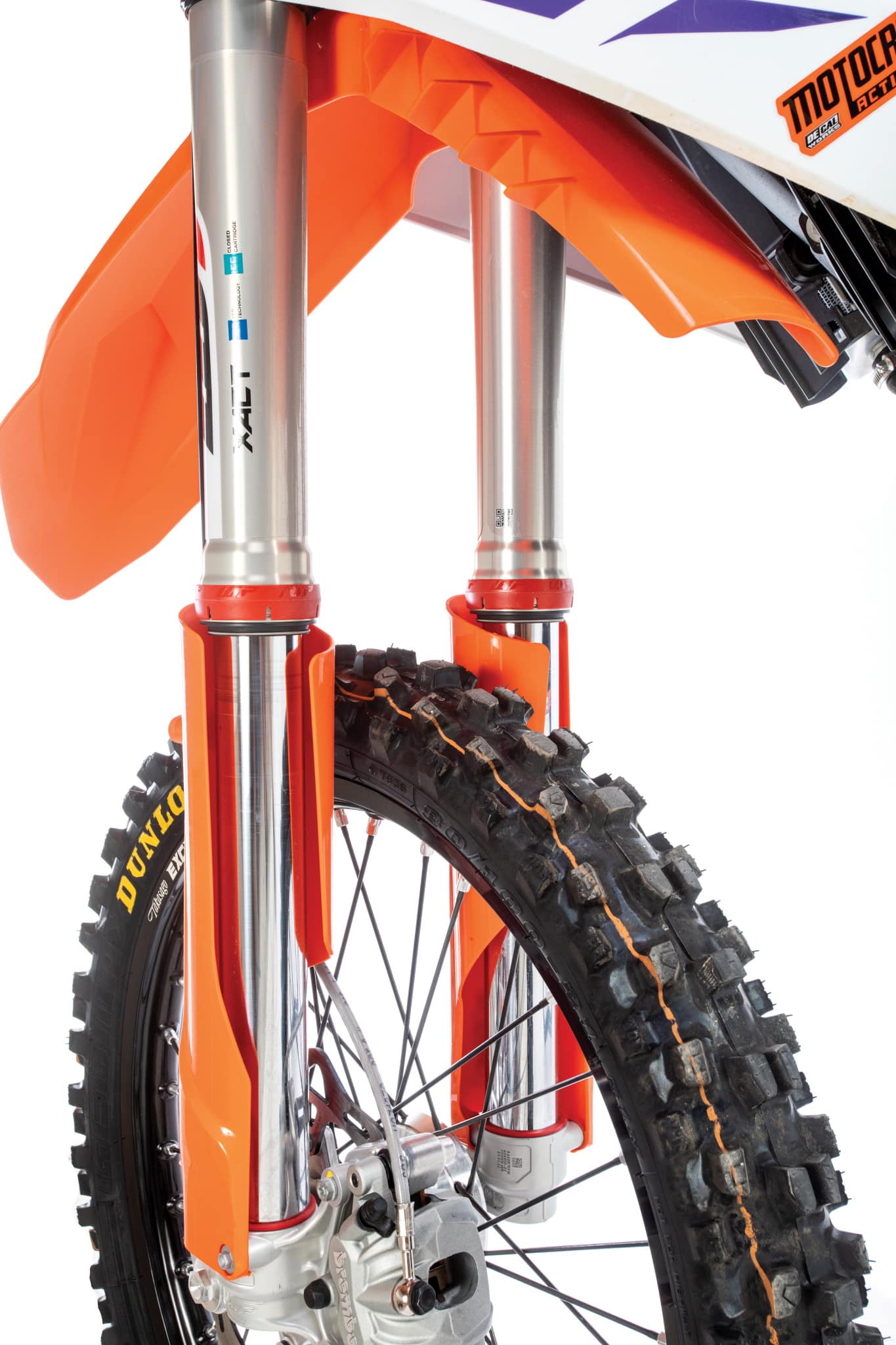 New fork guards wrap farther around the fork tubes.
New fork guards wrap farther around the fork tubes.
Q: WHAT DID WE HATE?
A: The hate list:
(1) Seat height. Motocross bikes keep getting taller, and that is especially true of the 2023 KTM 450SXF. It is skyscraper tall. If you don’t have long legs, your boots aren’t going to touch the ground.
(2) Chain slack. If you don’t set your chain slack at 70mm, the chain will eat the front edge of the chain buffer pad (up by the countershaft sprocket). Keep an eye on the lower chain pad also. The chain is not right if it doesn’t look too loose.
(3) Fork guards. If the right fork guard is not aligned perfectly, the top of it will hit against the fender and crack the guard
(4) Brake petal tip. It gets crushed, bent, or broken in any crash or collision you have. There are much stronger aftermarket tips available.
(5) Wheel spacers. Unlike on the last 20 years of KTMs, you cannot run your older spare rear wheel on the 2023 model without changing the seals and spacer tube.
(6) Push buttons. We like the push buttons on the new electronics for start, stop, traction control, maps and Quick Shift, but the buttons are so low-profile that getting them depressed with a gloved hand is often hit-or-miss.
(7) Finding neutral. Getting the transmission into neutral on the starting line is hard. Sometimes it helps to rev the engine really high and then snick the shift lever before the rpm falls off.
(8) Weight. Although it is still lighter than all the Japanese 450s, it isn’t as light as it was in 2022, by 6 pounds.
(9) Spokes. KTM claims to have new spoke nipples that won’t come loose. Wrong! The new spoke nipples come loose more frequently than the old ones.
(10) Shock linkage. On an undetermined number of KTMs, the needle bearings walk out of the linkage and bind it up. We replace the needle bearings with a new caged bearing (KTM part number 58033097000).
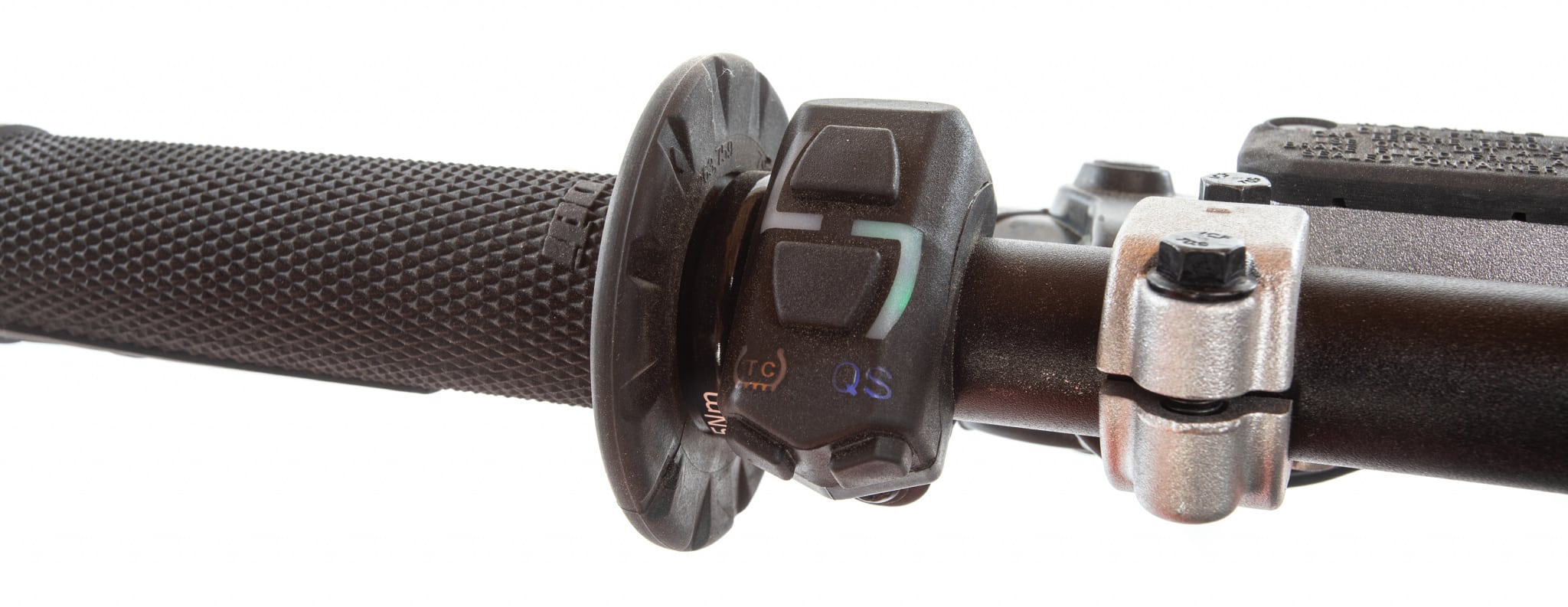 Launch Control is activated by pressing the Traction Control (TC) and Quick Shift (QS) buttons at the same time.
Launch Control is activated by pressing the Traction Control (TC) and Quick Shift (QS) buttons at the same time.
Q: WHAT DID WE LIKE?
A: The like list:
(1) Shock tower. We like that the top of the shock is no longer connected to the frame’s backbone. It redirects its energy downward to the strongest part of the frame instead of up into the head tube.
(2) Quick Shift. It’s great for long high-speed starts but can be quirky in half-throttle situations.
(3) Wider front fender. The new front fender is 1 inch wider and comes with four 1-inch winglets on the back half of the fender to widen the rear of the fender without cutting down on air flow to the radiators. It is a very heavy front fender, and the narrower and lighter 2022 front fender will fit.
(4) Map 2. A great map. It is smoother off the bottom with reduced engine braking and very linear power that takes off in the middle and goes until the blood rushes out of your brain.
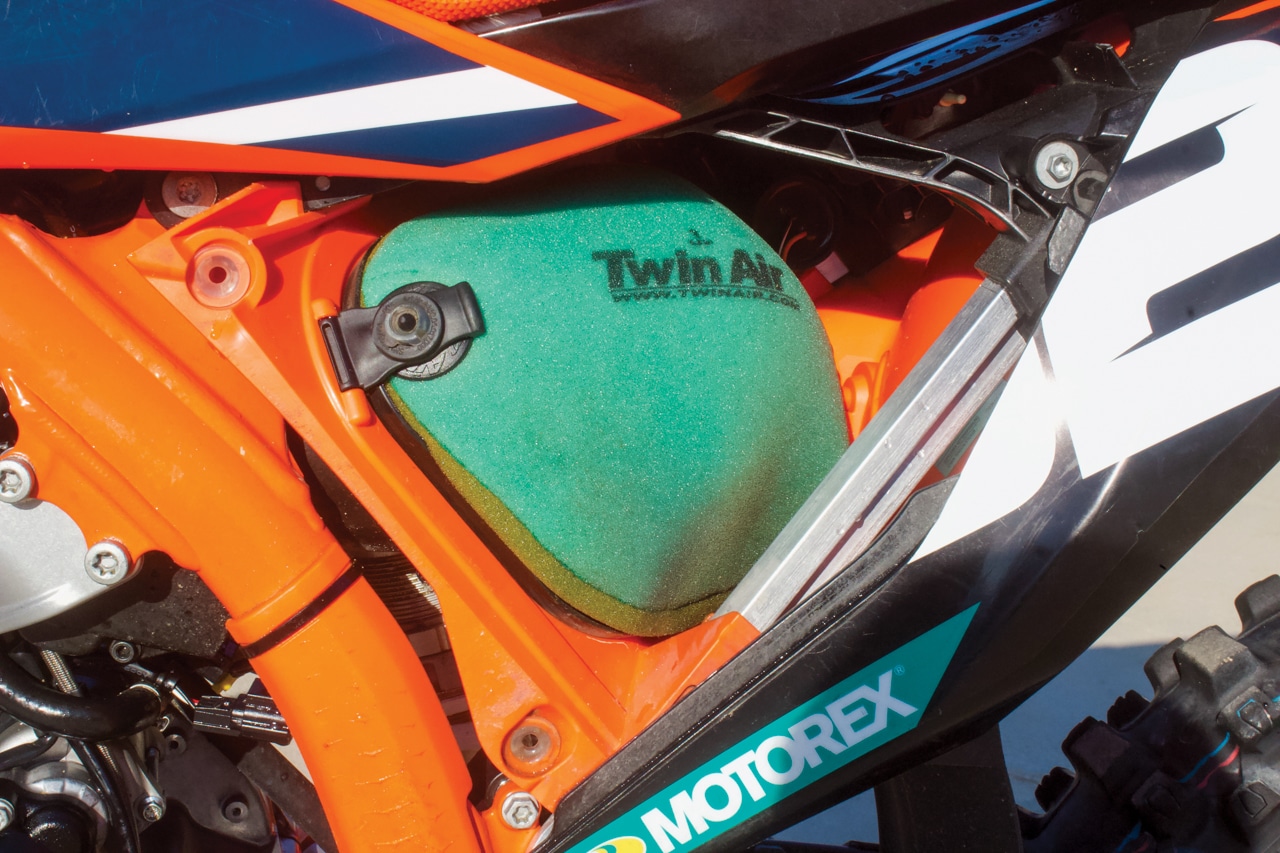
(5) Air filter. The easiest air filter to change. Plus, if you look closely at the top center of the cage, there is an embossed arrow to tell you which end is up (and there is an arrow on the Twin Air filter also).
(6) Airbox cover. It has a handle molded into the upper front corner that makes it easier to get the cover off. Plus, KTM has an optional vented airbox cover that improves throttle response.
(7) Kill button. The previous kill button was mounted inboard on the left handlebar. For 2023, the kill button and start button share a fitting on the right side of the handlebar. Again, the buttons could be raised up higher for easier use.
(8) Idiot light. In 2022, the FI diagnostic’s LED light fell out of its holders constantly. For 2023, the idiot light has been moved to the hour meter.
(9) Fork guards. New fork guards wrap farther around the exposed fork legs to cut down on chrome dings.
Q: WHAT DO WE REALLY THINK?
A: The 2023 KTM 450SXF is a first-year model, and common motocross wisdom says you should never buy a first-year model. We think this is good advice for any potential buyer who does not have lots of KTM experience. The hardcore KTM guys will work through the issues by applying what they learned in the past and will love the technical advances that KTM made in 2023. However, it might be smarter to wait for the 2024 model…or consider a 2023 GasGas MC450F, because it has last year’s engine, frame, shock and linkage.
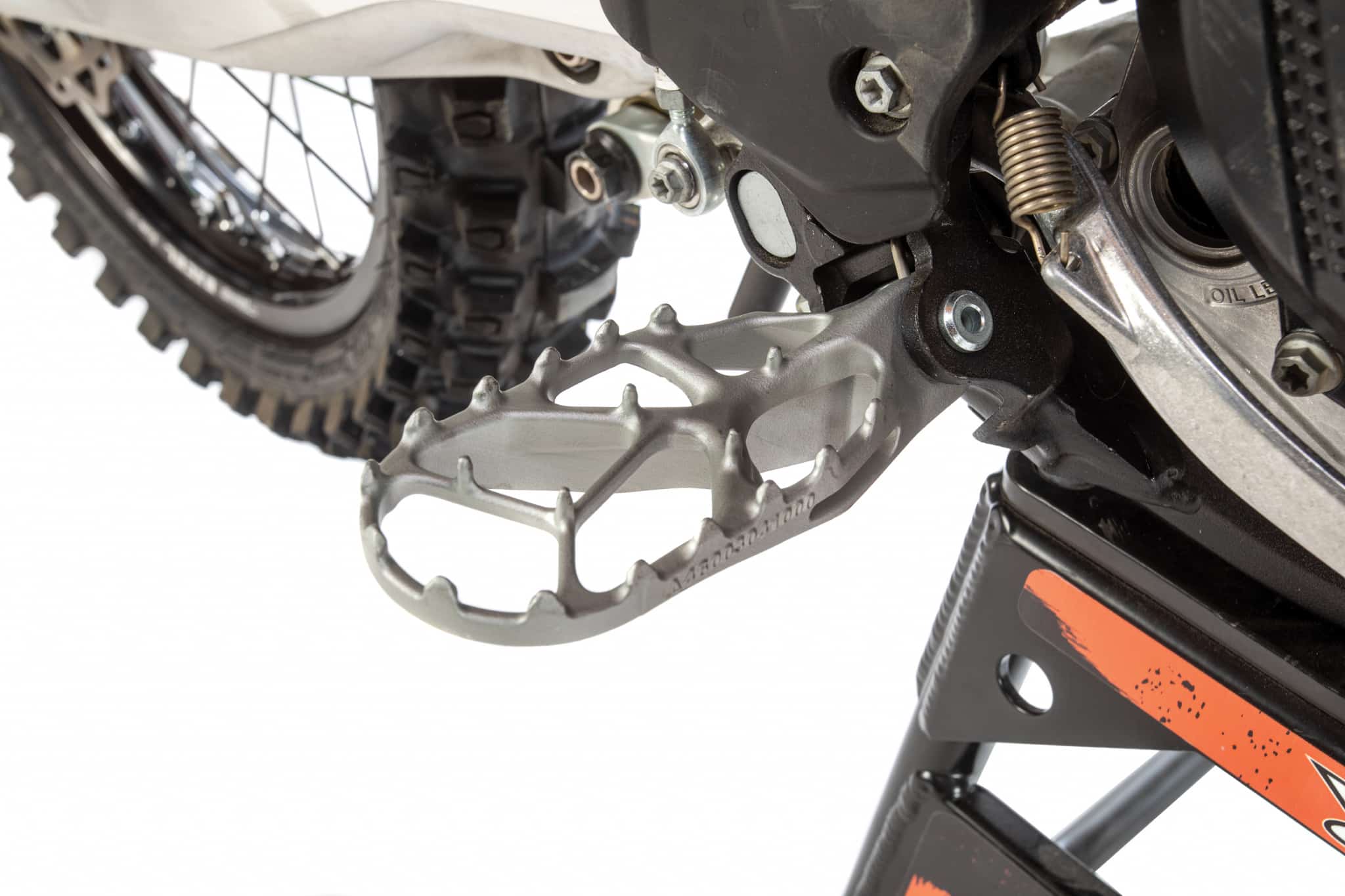
MXA’S 2023 KTM 450SXF SETUP SPECS:
This is how we set up our 2023 KTM 450SXF suspension for racing. We offer it as a guide to help you find your own sweet spot.
WP AER FORK SETTINGS
There is a learning curve to getting the most out of the WP XACT air forks. The KTM WP XACT air fork has one Schrader valve to put air in or take air out. The right fork leg is strictly damping, and the left leg is air only. KTM has a sticker on the air leg to guide you to the recommended air pressure. It is a very good starting point, but it’s just a suggestion, not an ironclad law. MXA has test riders who run as much as 165 psi and test riders who run as low as 135 psi. The 2023 forks have the potential to be great. For hardcore racing, we recommend this fork setup for an average rider on the 2023 KTM 450SXF.
Spring rate: 158 psi (Expert), 152 psi (Intermediate), 145 psi (Vet), 138 psi (Novice)
Compression: 14 clicks out (12 clicks out)
Rebound: 15 clicks out (18 clicks out)
Fork-leg height: Third line
Notes: The 2023 KTM 450SXF comes with rubber rings on each leg to allow the rider to see how much travel he is getting at a given pressure, but the orange rings wear out and slide down by themselves after a couple of hours. The forks need five hours of break-in time before they smooth out and work to their fullest.
WP SHOCK SETTINGS
Most MXA test riders liked the overall feel of the WP rear shock, especially after KTM lowered the shock spring rate in 2017 from 48 N/mm to 45 N/mm. WP did make some technical changes to the 2023 WP XACT shock to make the damping stiffer. We run the low-speed compression on 10 clicks out, the high-speed compression 1-1/2 turns out, the rebound on 15 clicks out and set the sag at 105mm. We do have issues with the last couple inches of shock travel. The shock blows through, which causes the bike to kick or worse yet to hop to one side or the other. This is a rising rate issue that needs a different shock linkage—one with more rising rate at the end of the stroke. Until those are available, we went for stiffer low-speed compression. For hardcore racing, we recommend this shock setup for the 2023 KTM 450SXF.
Spring rate: 45 N/mm (for 175-and-up pounds), 42 N/mm (for riders under 175 pounds)
Race sag: 105mm
Hi-compression: 1-1/2 turns out
Lo-compression: 10 clicks out
Rebound: 15 clicks out
Notes: When we have doubts about the shock’s compression in normal size bumps and landings, we focus on changing the high-speed compression, not the low-speed. However, if the rear end feels like it is bottoming and kicking, we go in on the low-speed. The aftermarket is busy making new shock linkages for the 2023 KTMs and Husqvarna’s—make sure they are going for more rising rate at the end of the shock’s stroke before laying your money down.
If your static sag is more than the recommended 40mm, your spring may be too stiff for your weight. In this case, the spring is not compressed enough to allow the suspension to extend far enough on its own. If your static sag is less than 30mm in the rear, the spring may be too soft for your weight. In this case, the spring requires so much preload to achieve the proper race sag that it makes the rear suspension prone to topping out under a load.


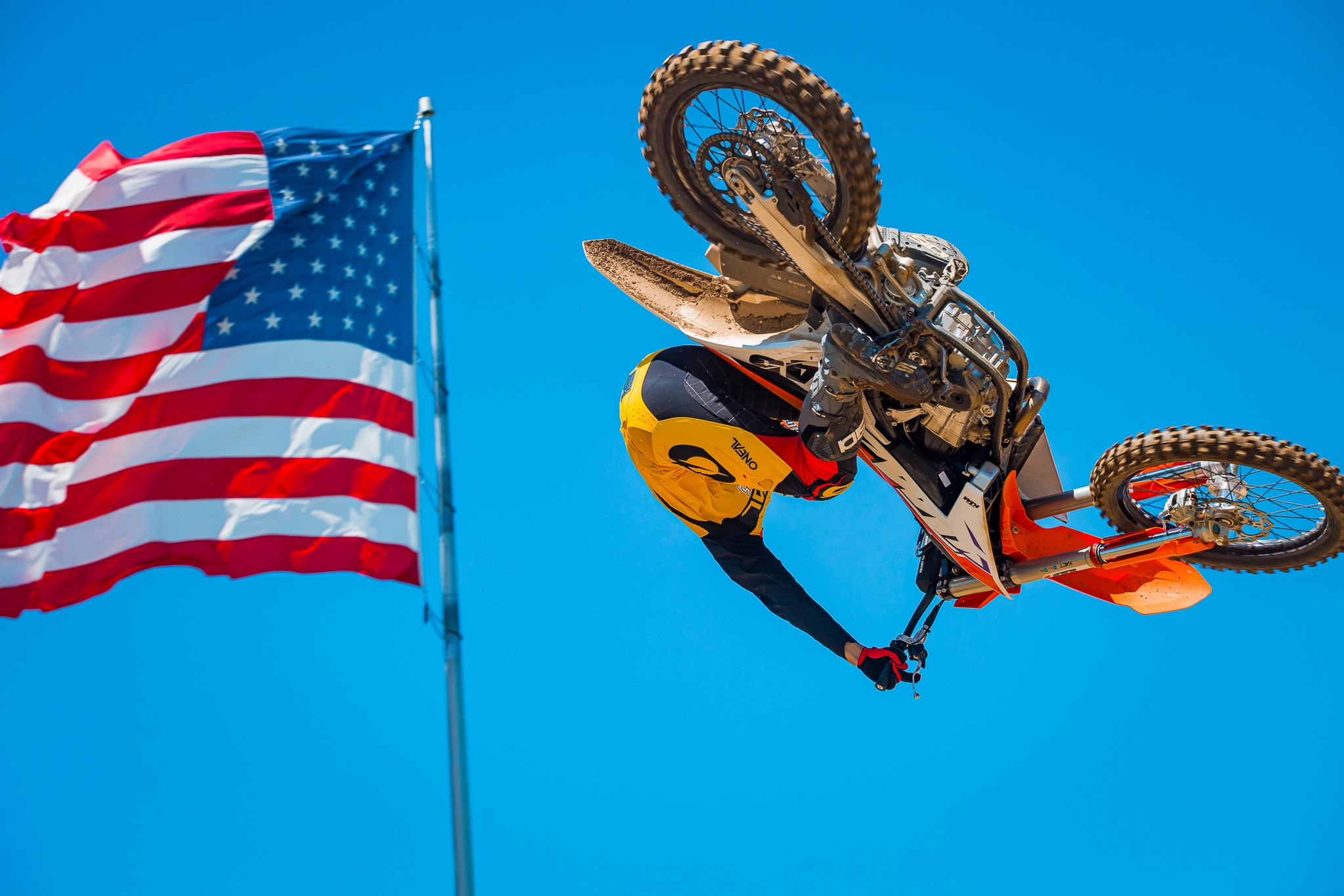
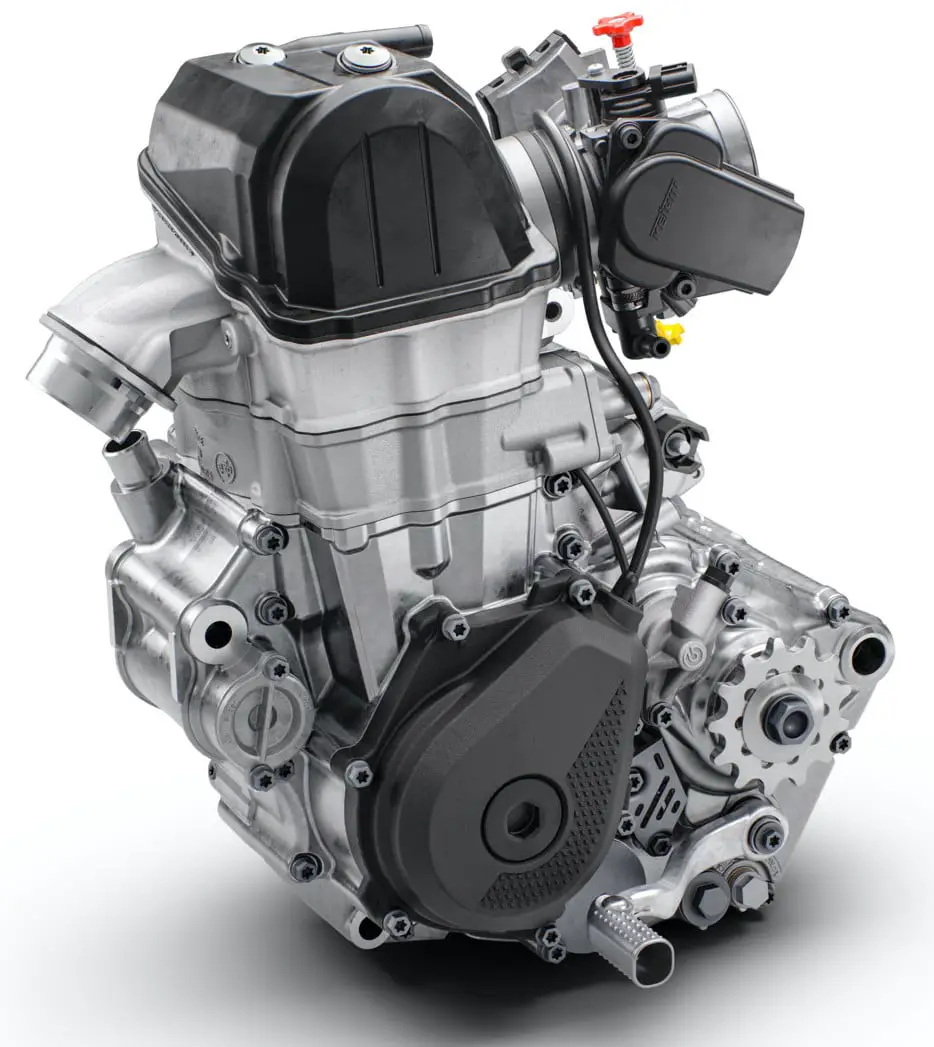
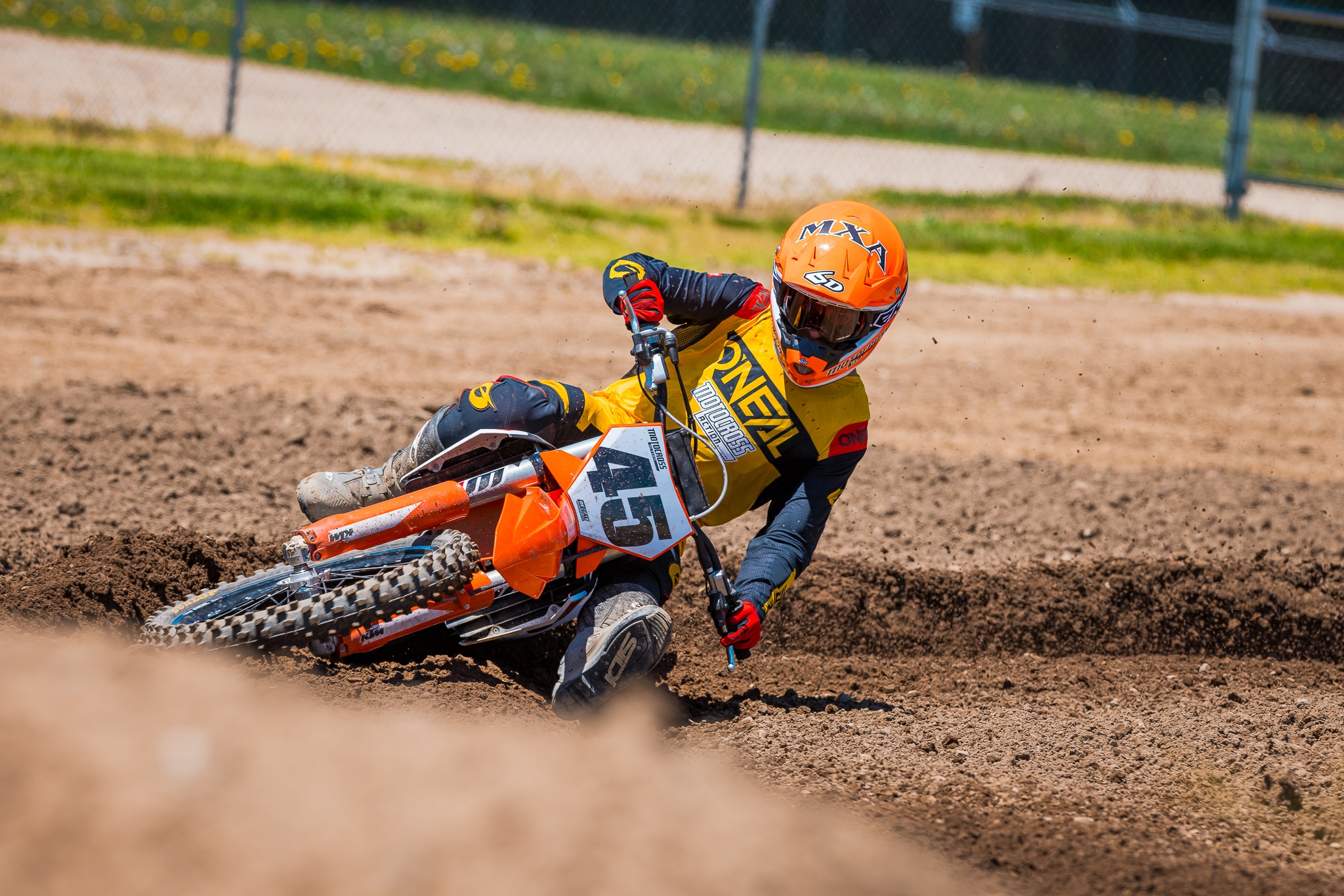

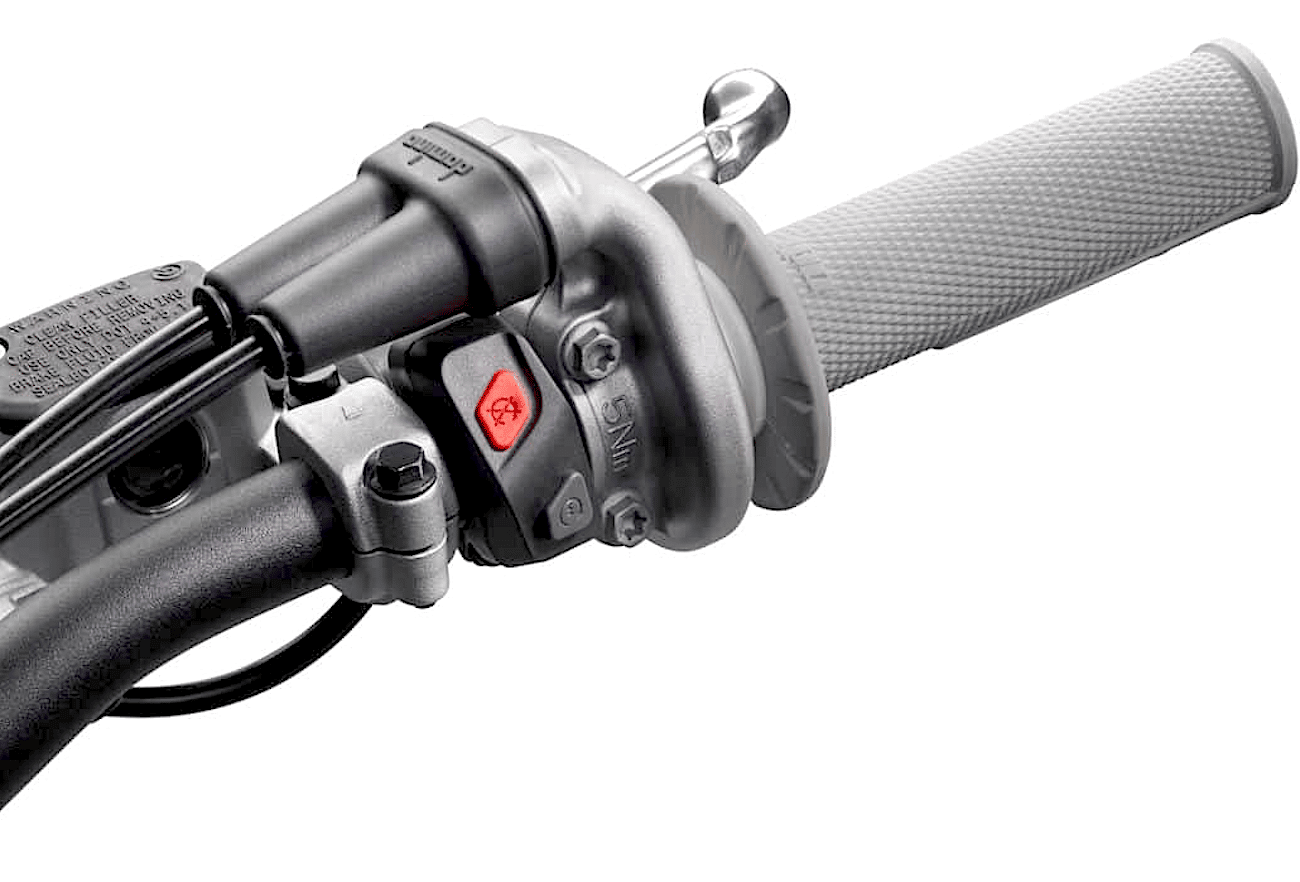




Comments are closed.